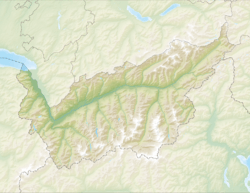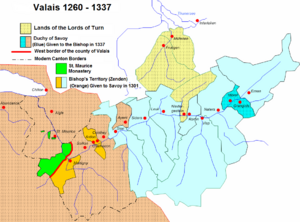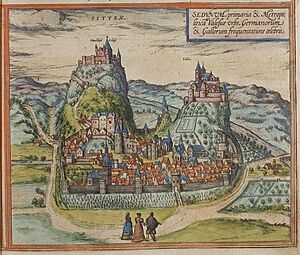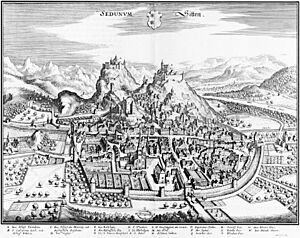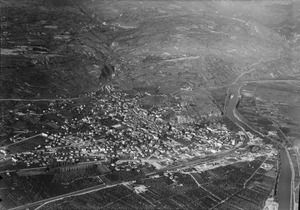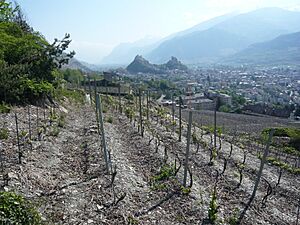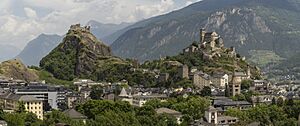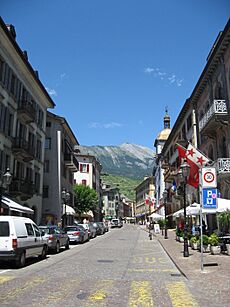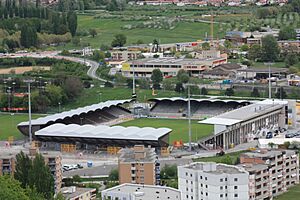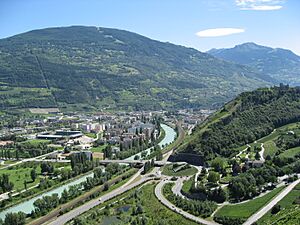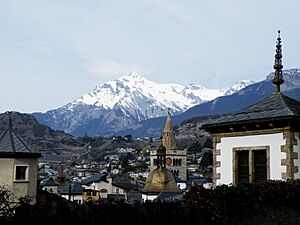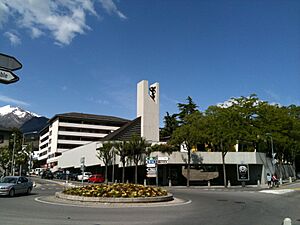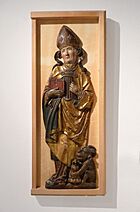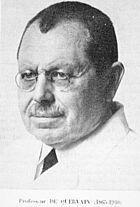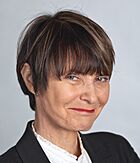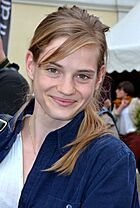Sion, Switzerland facts for kids
Quick facts for kids
Sion
|
||
|---|---|---|

Sion as seen from Nax, Mont-Noble
|
||
|
||
| Country | Switzerland | |
| Canton | Valais | |
| District | Sion | |
| Area | ||
| • Total | 34.86 km2 (13.46 sq mi) | |
| Elevation
(gare)
|
491 m (1,611 ft) | |
| Population
(Dec 2020 )
|
||
| • Total | 34,978 | |
| • Density | 1,003.38/km2 (2,598.8/sq mi) | |
| Demonym(s) | ||
| Postal code |
1950 Sion, 1958 02 Uvrier, 1962 Pont-de-la-Morge (Sion), 1967 Bramois, 1991 00 Salins, 1991 02 Arvillard (Salins), 1991 03 Pravidondaz (Salins), 1991 04 Turin (Salins), 1991 05 Misériez (Salins), 1992 00 Les Agettes, 1992 01 Les Mayens-de-Sion, 1992 02 La Vernaz (Les Agettes), 1992 03 Crête-à-l'Oeil (Les Agettes), 1993 Veysonnaz
|
|
| Surrounded by | Ayent, Conthey, Grimisuat, Grône, Mont-Noble, Nendaz, Saint-Léonard, Savièse, Vex | |
Sion is a city in Switzerland. It is the capital of the Valais region and the Sion district. As of 2023, about 35,000 people live there. People from Sion are called Sédunois(es) in French.
Sion is known for its two famous castles, the Basilique de Valère and the Château de Tourbillon. It also has an airport used for both civilian flights and military air rescue missions. Over the years, some smaller towns like Bramois, Salins, and Les Agettes have joined with Sion.
Contents
History of Sion
Early Settlements


Sion is a very old place with signs of human life going back to 6200 BC. This makes it one of the most important prehistoric sites in Europe. Around 5800 BC, early farmers from the Mediterranean area came to live here.
Over time, more people settled in Sion, especially around 4500 BC. To support the growing population, farming and raising animals became very important. People also started burying their dead in special stone tombs called cists. These tombs sometimes had carved stones called stelae with human-like figures. Later, around 3000 BC, they built larger shared tombs from dry stone walls, like the Dolmen of Le Petit-Chasseur.
Archaeologists have found many ancient homes and burial sites in Sion. These include huts from the Middle Neolithic period and large burial grounds from the Late Bronze Age and Iron Age.
Celtic and Roman Times
Around 100 BC, Sion was the main town for the Seduni, one of the four Celtic tribes in the Valais region. The famous Roman leader Julius Caesar even mentioned them. The Romans conquered the area around 10 BC.
Under Roman rule, Sion was known as Sedunum. It was an important Roman settlement, with large bath complexes and fancy villas. Even though another town, Martigny, became the capital of the region later, Sion remained home to many important Roman families.
The Bishop's Home
The diocese of Sion is the oldest in Switzerland. It's one of the oldest church areas north of the Alps! The first known bishop, Saint Theodore (who died in 391 AD), helped build a church in Sion. He also founded the Abbey of Saint-Maurice, which is the oldest abbey north of the Alps.
In 589 AD, the bishop moved his main office to Sion. This happened because the old location, Octodurum (now Martigny), was often flooded. The first main church in Sion was likely built around the 6th century.
Sion became even more important in 999 AD. The King of Burgundy gave the entire Valais region to the bishop. This made Sion the capital of the region. The bishop became a powerful prince-bishop, with the right to make laws and choose local leaders.
Medieval Sion
During the Middle Ages, the people of Sion slowly gained more freedom from the bishop's rule. In 1217, the city got its first written rules, which covered laws, punishments, and market rules. By 1269, the citizens had their own council to help govern the town. These leaders were later called syndics.
In 1338, the bishop confirmed the city's rights and freedoms. The next year, the Holy Roman Emperor made Sion a free imperial city. This meant it had special rights and was directly under the emperor's protection. Sion now had city walls, its own rules, and the right to hold markets.
Later Medieval Times to the 1700s
From the mid-1300s to 1475, Sion faced many wars and was often attacked. Bishops and powerful families fought over control. Despite this, the citizens worked hard to keep and expand their rights. By the mid-1500s, the city had a lot of control over its own affairs.
In the 16th century, many German-speaking people moved to Sion. Because of this, the city became mostly German-speaking. Official city records started being written in German instead of Latin.
The 1600s and 1700s were more peaceful. A new city hall was built. However, a big fire in 1788 damaged many buildings, including the castles.
Over time, not everyone in Sion had the same rights. Some were full citizens, while others were "permanent residents" or "tollerati" (meaning they were allowed to live there but had fewer rights). By the late 1700s, citizens were actually a minority in the city.
Sion was an important stop for trade between northern Italy and other parts of Europe. Goods traveled through the Simplon Pass and the Valais region. The city had warehouses and stables for traders. Many local businesses like mills, sawmills, tanneries, and guilds (groups of craftsmen like smiths or bakers) grew in Sion.
The city had several churches. The main church, Notre-Dame-du-Glarier, was rebuilt in the 1400s after being destroyed in a war. St. Theodul's church, built on Roman ruins, served the French-speaking people.
In the 1500s, some people in Sion became Protestant. However, the Valais government decided to stay Catholic. Many Protestants either left or returned to the Catholic faith. Catholic groups like the Capuchin friars and Jesuits helped strengthen the Catholic Church in Sion.
From the Late 1700s to 1848
At the end of the 1700s, Sion was a place where old traditions were strong. But after the French invasion of Switzerland in 1798, revolutionary ideas spread. Sion was caught between those who wanted change and those who wanted to keep things the same. The city was looted several times during this period.
Under the new Helvetic Republic, Sion was often a place of conflict. Napoleon Bonaparte later made the region an independent republic, and then part of France. After Napoleon's defeat, Sion was occupied by Austrian troops.
Between 1815 and 1839, the old noble families slowly regained power. This led to new political parties forming. Sion became the capital of Valais, but there were still conflicts between different parts of the region. In 1847, federal troops occupied Sion during a civil war known as the Sonderbund War.
Modern Sion
Sion has tried to host the Winter Olympics several times, for the 1976, 2002, 2006, and 2026 games, but was not chosen.
Recent Discoveries
In July 2019, archaeologists found six new standing stones in the La Petit district of Sion. This was near where 30 similar stones and ancient tombs were found in the 1960s.
Experts say this discovery is very important for understanding social rituals from around 2,500 BC in central Europe. Some of the stones were intentionally broken. The largest stone, weighing about two tons, is carved with a male figure wearing decorated clothes and a sun-like design around his face.
Geography
Sion covers an area of about 34.86 square kilometers (13.46 square miles). A large part of the land, about 38.9%, is used for farming. Forests cover 15.5% of the area. About 38.4% of the land has buildings or roads, and 7.2% is unproductive.
The Rhône river flows through the region. In the past, the river often flooded. In the 1800s and 1900s, the river was straightened and changed to control floods. Now, there's a new plan to make the river wider and safer, and to improve the environment around it.
Climate
Sion is one of the driest and sunniest places in Switzerland. It gets about 603 millimeters (23.7 inches) of rain or snow each year, over about 82 days. December is usually the wettest month, while April is the driest. Sion has a mild, temperate climate.
| Climate data for Sion (1991–2020) | |||||||||||||
|---|---|---|---|---|---|---|---|---|---|---|---|---|---|
| Month | Jan | Feb | Mar | Apr | May | Jun | Jul | Aug | Sep | Oct | Nov | Dec | Year |
| Mean daily maximum °C (°F) | 5.0 (41.0) |
7.6 (45.7) |
13.5 (56.3) |
17.6 (63.7) |
21.5 (70.7) |
25.4 (77.7) |
27.4 (81.3) |
26.6 (79.9) |
22.1 (71.8) |
16.9 (62.4) |
10.1 (50.2) |
5.1 (41.2) |
16.6 (61.9) |
| Daily mean °C (°F) | 0.5 (32.9) |
2.3 (36.1) |
7.2 (45.0) |
11.3 (52.3) |
15.3 (59.5) |
19.0 (66.2) |
20.6 (69.1) |
19.9 (67.8) |
15.7 (60.3) |
10.7 (51.3) |
5.0 (41.0) |
0.9 (33.6) |
10.7 (51.3) |
| Mean daily minimum °C (°F) | −3.0 (26.6) |
−1.9 (28.6) |
1.9 (35.4) |
5.3 (41.5) |
9.4 (48.9) |
13.0 (55.4) |
14.5 (58.1) |
14.1 (57.4) |
10.4 (50.7) |
6.1 (43.0) |
1.1 (34.0) |
−2.4 (27.7) |
5.7 (42.3) |
| Average precipitation mm (inches) | 52 (2.0) |
40 (1.6) |
37 (1.5) |
34 (1.3) |
52 (2.0) |
48 (1.9) |
62 (2.4) |
60 (2.4) |
38 (1.5) |
43 (1.7) |
50 (2.0) |
68 (2.7) |
583 (23.0) |
| Average snowfall cm (inches) | 9 (3.5) |
9 (3.5) |
2 (0.8) |
0 (0) |
0 (0) |
0 (0) |
0 (0) |
0 (0) |
0 (0) |
0 (0) |
6 (2.4) |
17 (6.7) |
43 (17) |
| Average precipitation days (≥ 1.0 mm) | 7.0 | 5.6 | 5.9 | 5.2 | 7.5 | 7.4 | 8.0 | 8.2 | 5.8 | 6.5 | 6.9 | 7.5 | 81.5 |
| Average snowy days (≥ 1.0 cm) | 1.9 | 1.3 | 0.3 | 0.1 | 0.0 | 0.0 | 0.0 | 0.0 | 0.0 | 0.0 | 0.7 | 2.4 | 6.7 |
| Average relative humidity (%) | 78 | 71 | 62 | 59 | 62 | 62 | 63 | 67 | 71 | 76 | 78 | 80 | 69 |
| Mean monthly sunshine hours | 93 | 131 | 188 | 210 | 229 | 254 | 271 | 250 | 208 | 160 | 96 | 68 | 2,158 |
| Percent possible sunshine | 53 | 58 | 60 | 59 | 56 | 61 | 65 | 65 | 65 | 59 | 50 | 50 | 60 |
| Source: MeteoSwiss | |||||||||||||
Sion's Coat of Arms
The city's coat of arms is a shield divided into two halves. The top half is silver with two red five-pointed stars. The bottom half is solid red.
People of Sion
As of 2023, Sion has a population of about 35,000 people. About 27% of the people living in Sion are from other countries.
Most people in Sion (about 82%) speak French as their main language. German is the second most common language (about 5.6%), followed by Portuguese (3.4%) and Italian (3.1%).
In 2000, about 24.8% of the population were children and teenagers (0–19 years old). Adults (20–64 years old) made up 60.7%, and seniors (over 64 years old) were 14.5%.
The average household in Sion has about 2.3 people. Many households (about 4,114) have only one person.
Population History
The chart below shows how Sion's population has changed over time.
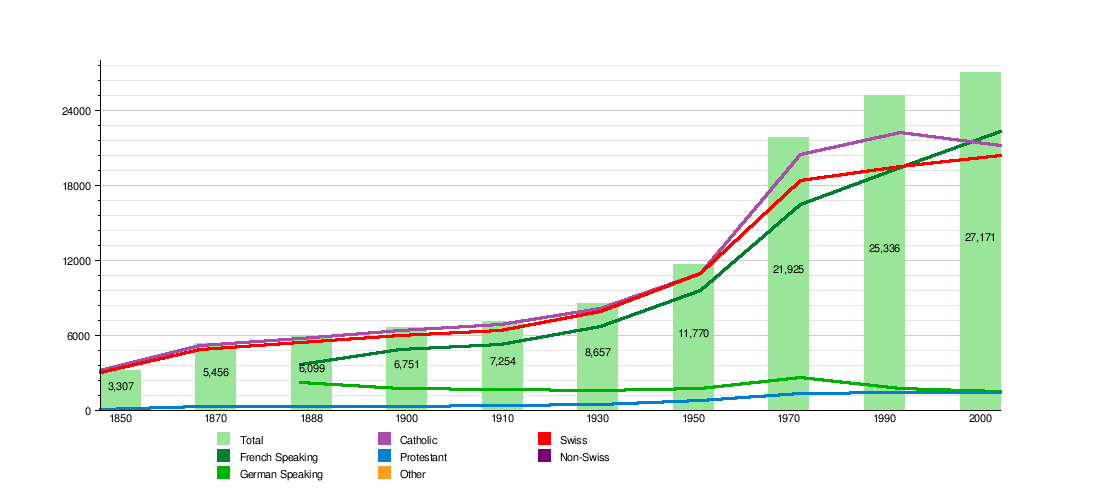
| Historic Population Data | |||||||||||
|---|---|---|---|---|---|---|---|---|---|---|---|
| Year | Total Population | French Speaking | German Speaking | Catholic | Protestant | Other | Jewish | Islamic | No religion given | Swiss | Non-Swiss |
| 1850 | 3,307 | 3,213 | 94 | 3,073 | 234 | ||||||
| 1870 | 5,456 | 5,178 | 296 | 4,857 | 618 | ||||||
| 1888 | 6,099 | 3,641 | 2,273 | 5,787 | 310 | 10 | 5,476 | 623 | |||
| 1900 | 6,751 | 4,892 | 1,733 | 6,417 | 319 | 1 | 9 | 5,972 | 779 | ||
| 1910 | 7,254 | 5,318 | 1,695 | 6,855 | 381 | 11 | 10 | 6,379 | 875 | ||
| 1930 | 8,657 | 6,726 | 1,633 | 8,168 | 472 | 11 | 3 | 7,931 | 726 | ||
| 1950 | 11,770 | 9,604 | 1,797 | 10,967 | 767 | 16 | 5 | 11,065 | 705 | ||
| 1970 | 21,925 | 16,478 | 2,646 | 20,458 | 1,333 | 755 | 12 | 33 | 51 | 18,411 | 3,514 |
| 1990 | 25,336 | 19,430 | 1,735 | 22,263 | 1,400 | 3,028 | 12 | 430 | 707 | 19,524 | 5,812 |
| 2000 | 27,171 | 22,338 | 1,523 | 21,220 | 1,419 | 2,455 | 15 | 1,360 | 1,371 | 20,360 | 6,811 |
Economy and Jobs
The main part of Sion's economy is the tertiary sector. This means services, like government offices, tourism, and healthcare. Sion is the capital of the Valais region, so many government jobs are here. Its historic castles and museums also attract tourists.
Sion is the third-largest wine-making area in Switzerland. However, land used for vineyards is shrinking because of city growth.
Sion is also important for medicine. It has a hospital, a central institute for hospitals in Valais, and a clinic for physical rehabilitation.
The city also has a waste incinerator. It burns waste from 44 nearby towns. The heat from burning waste is turned into electricity for local communities.
In 2014, over 33,000 people worked in Sion. Most jobs were in the service sector. A smaller number worked in manufacturing and construction. Only a small percentage of the population received social assistance.
Important Landmarks
Sion has 14 buildings or sites that are listed as important Swiss heritage sites. These include:
- The Archives of Valais (where old records are kept).
- The Archives and Museum of the Bishop of Sion.
- The main church, Cathédrale Notre-Dame.
- The town hall, which has a special astronomical clock.
- Majorie Castle and La Majorie.
- Le Vidomnat and Maison Supersaxo.
- The Médiathèque Valais Sion (a library).
- The Cantonal Fine Arts and History Museums.
- The ruins of Tourbillon Castle.
- The Capuchin monastery and library.
- The church of the Valère Basilica (12th–13th century).
- The church of St-Théodule.
- Ancient settlement remains and the modern city itself.
Sion's old town is famous for its medieval look. It's dominated by two hills: Valère (610 meters high) with the Valère Basilica, and Tourbillon (658 meters high) with the ruins of Tourbillon Castle. The Valère Basilica has the oldest playable organ in the world, built in the 1430s.
Airshows
Sion's airport has hosted public airshows. Famous aerobatic teams, like the Frecce Tricolori from Italy and the Patrouille de France, have performed there.
Sports
Sion has a professional football (soccer) team called FC Sion. They play in the top Swiss league at the Stade Tourbillon.
The city's main Ice hockey team is HCV Sion. They play in the Swiss Premiere League, which is the third level of Swiss hockey.
In 2021, Alaia Bay, a surfing wave pool, opened in Sion. It's the first public surf pool in mainland Europe.
Media
Sion is home to several news outlets:
- Le Nouvelliste: A daily newspaper for the Valais region.
- Canal 9: A regional TV station for Valais.
- Rhône FM: A private radio station for Valais.
- TSR: A public Swiss TV station.
Education
Many people in Sion have a good education. About 31.5% have finished high school, and 13.5% have gone on to higher education, like university.
Sion has four libraries, including the Médiathèque Valais Sion. In 2008, these libraries had over 690,000 books and other media.
Schools in Sion
Sion has two high schools:
- The Lycée-Collège des Creusets (LCC)
- The Lycée-Collège de la Planta (LCP)
Other schools in Sion include:
- The Ecole d’agriculture du Valais (Agriculture School).
- A circus school.
- A jazz school.
- HES-SO Valais: A technical college that teaches science, engineering, economics, IT, and health sciences.
- HEM Valais (Conservatoire Supérieur et Académie de Musique Tibor Varga): A music academy.
- Institut Universitaire Kurt Bösch: A university for business and tourism.
Transport
Sion is easy to reach. It's located on the main railway line and a major motorway. It also has its own airport.
Religion
Based on a 2000 survey, most people in Sion (about 78.1%) are Roman Catholic. About 4.4% belong to the Swiss Reformed Church (Protestant). There are also smaller numbers of people who are Orthodox Christian, Muslim, Buddhist, and Hindu. About 5% of the population reported having no religion.
Famous People from Sion
Many notable people have connections to Sion, including:
- Saint Theodore of Octodurum (4th century): A patron saint of Valais.
- Ignaz Venetz (1788–1859): A Swiss engineer and glaciologist.
- Fritz de Quervain (1868–1940): A Swiss surgeon known for his work on thyroid disease.
- Walther Ritz (1878–1909): A theoretical physicist.
- Hermann Geiger (1914–1966): A Swiss aviator and air rescue pilot.
- Micheline Calmy-Rey (born 1945): A politician who was president of Switzerland in 2007 and 2011.
- Stéphane Udry (born 1961): An astronomer who searches for planets outside our solar system.
- Noémie Schmidt (born 1990): A Swiss actress.
- Sports Stars
- Marco Pascolo (born 1966): A retired Swiss international football goalkeeper.
- Sophie Lamon (born 1985): A Swiss fencer who won a silver medal at the 2000 Summer Olympics.
- Gelson Fernandes (born 1986): A footballer who played many games for clubs and the national team.
- Estelle Balet (1994–2016): A Swiss freeride snowboarder and two-time world champion.
- Edimilson Fernandes (born 1996): A footballer.
Sister Cities
Sion is connected with other cities around the world:
|
Images for kids
-
Sion as seen from Nax, Mont-Noble
See also
 In Spanish: Sion (Suiza) para niños
In Spanish: Sion (Suiza) para niños




